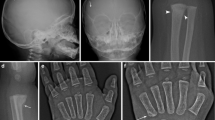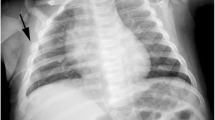Abstract
Background
Skeletal surveys are routinely performed in cases of suspected child abuse, but there are limited data regarding the yield of high-detail skeletal surveys in infants.
Objective
To determine the diagnostic yield of high-detail radiographic skeletal surveys in suspected infant abuse.
Material and methods
We reviewed the high-detail American College of Radiology standardized skeletal surveys performed for suspected abuse in 567 infants (median: 4.4 months, SD 3.47; range: 4 days-12 months) at a large urban children’s hospital between 2005 and 2013. Skeletal survey images, radiology reports and medical records were reviewed. A skeletal survey was considered positive when it showed at least one unsuspected fracture.
Results
In 313 of 567 infants (55%), 1,029 definite fractures were found. Twenty-one percent (119/567) of the patients had a positive skeletal survey with a total of 789 (77%) unsuspected fractures. Long-bone fractures were the most common injuries, present in 145 children (26%). The skull was the site of fracture in 138 infants (24%); rib cage in 77 (14%), clavicle in 24 (4.2%) and uncommon fractures (including spine, scapula, hands and feet and pelvis) were noted in 26 infants (4.6%). Of the 425 infants with neuroimaging, 154 (36%) had intracranial injury. No significant correlation between positive skeletal survey and associated intracranial injury was found. Scapular fractures and complex skull fractures showed a statistically significant correlation with intracranial injury (P = 0.029, P = 0.007, respectively).
Conclusion
Previously unsuspected fractures are noted on skeletal surveys in 20% of cases of suspected infant abuse. These data may be helpful in the design and optimization of global skeletal imaging in this vulnerable population.







Similar content being viewed by others
References
Caffey J (1946) Multiple fractures in the long bones of infants suffering from chronic subdural hematoma. Am J Roentgenol Radium Ther 56:163–173
Kempe CH, Silverman FN, Steele BF et al (1962) The battered-child syndrome. JAMA 181:17–24
Silverman FN (1953) The roentgen manifestations of unrecognized skeletal trauma in infants. Am J Roentgenol Radium Ther Nucl Med 69:413–427
Wheeler SM, Williams L, Beauchesne P et al (2013) Shattered lives and broken childhoods: Evidence of physical child abuse in ancient Egypt. International Journal of Paleopathology 3:71–82
Maguire S (2010) Which injuries may indicate child abuse? Arch Dis Child Educ Pract Ed 95:170–177
Leventhal JM, Martin KD, Asnes AG (2008) Incidence of fractures attributable to abuse in young hospitalized children: results from analysis of a United States database. Pediatrics 122:599–604
Merten DF, Radkowski MA, Leonidas JC (1983) The abused child: a radiological reappraisal. Radiology 146:377–381
Loder RT, Feinberg JR (2007) Orthopaedic injuries in children with nonaccidental trauma: demographics and incidence from the 2000 kids’ inpatient database. J Pediatr Orthop 27:421–426
ACR-SPR practice guideline for skeletal surveys in children: revised 2011 (resolution 54). J Am Coll Radiol 1–6
Duffy SO, Squires J, Fromkin JB et al (2011) Use of skeletal surveys to evaluate for physical abuse: analysis of 703 consecutive skeletal surveys. Pediatrics 127:e47–52
Karmazyn B, Lewis ME, Jennings SG et al (2011) The prevalence of uncommon fractures on skeletal surveys performed to evaluate for suspected abuse in 930 children: should practice guidelines change? AJR Am J Roentgenol 197:W159–W163
Day F, Clegg S, McPhillips M et al (2006) A retrospective case series of skeletal surveys in children with suspected non-accidental injury. J Clin Forensic Med 13:55–59
Lindberg DM, Berger RP, Reynolds MS et al (2014) Yield of skeletal survey by age in children referred to abuse specialists. J Pediatr. doi:10.1016/j.jpeds.2014.01.068
Barber I, Perez-Rossello JM, Wilson CR et al (2013) Prevalence and relevance of pediatric spinal fractures in suspected child abuse. Pediatr Radiol 43:1507–1515
Lindberg DM, Harper NS, Laskey AL et al (2013) Prevalence of abusive fractures of the hands, feet, spine, or pelvis on skeletal survey: perhaps “uncommon” is more common than suggested. Pediatr Emerg Care 29:26–29
King J, Diefendorf D, Apthorp J et al (1988) Analysis of 429 fractures in 189 battered children. J Pediatr Orthop 8:585–589
Akbarnia B, Torg JS, Kirkpatrick J et al (1974) Manifestations of the battered-child syndrome. J Bone Joint Surg Am 56:1159–1166
Kogutt MS, Swischuk LE, Fagan CJ (1974) Patterns of injury and significance of uncommon fractures in the battered child syndrome. Am J Roentgenol Radium Ther Nucl Med 121:143–149
Loder RT, Bookout C (1991) Fracture patterns in battered children. J Orthop Trauma 5:428–433
Kleinman PK, Marks SC Jr, Richmond JM et al (1995) Inflicted skeletal injury: a postmortem radiologic-histopathologic study in 31 infants. AJR Am J Roentgenol 165:647–650
Carty H, Pierce A (2002) Non-accidental injury: a retrospective analysis of a large cohort. Eur Radiol 12:2919–2925
Beals RK, Tufts E (1983) Fractured femur in infancy: the role of child abuse. J Pediatr Orthop 3:583–586
Thomas SA, Rosenfield NS, Leventhal JM et al (1991) Long-bone fractures in young children: distinguishing accidental injuries from child abuse. Pediatrics 88:471–476
Stewart G, Meert K, Rosenberg N (1993) Trauma in infants less than three months of age. Pediatr Emerg Care 9:199–201
Pierce MC, Bertocci G (2008) Injury biomechanics and child abuse. Annu Rev Biomed Eng 10:85–106
Caffey J (1957) Some traumatic lesions in growing bones other than fractures and dislocations: clinical and radiological features: the Mackenzie Davidson memorial lecture. Br J Radiol 30:225–238
Kleinman PK, Marks SC, Blackbourne B (1986) The metaphyseal lesion in abused infants: a radiologic-histopathologic study. AJR Am J Roentgenol 146:895–905
Barrett IR, Kozlowski K (1979) The battered child syndrome. Australas Radiol 23:72–82
Galleno H, Oppenheim WL (1982) The battered child syndrome revisited. Clin Orthop Relat Res 162:11–19
Karmazyn B, Duhn RD, Jennings SG et al (2011) Long bone fracture detection in suspected child abuse: contribution of lateral views. Pediatr Radiol 42:463–469
Kleinman PK (1998) Diagnostic imaging of child abuse, 2nd edn. Mosby-Year Book Inc., St. Louis, MO
Kleinman PK, Perez-Rossello JM, Newton AW et al (2011) Prevalence of the classic metaphyseal lesion in infants at low versus high risk for abuse. AJR Am J Roentgenol 197:1005–1008
Lysack JT, Soboleski D (2003) Classic metaphyseal lesion following external cephalic version and cesarean section. Pediatr Radiol 33:422–424
O’Connell A, Donoghue VB (2007) Can classic metaphyseal lesions follow uncomplicated caesarean section? Pediatr Radiol 37:488–491
Kleinman PK, Marks SC Jr (1998) A regional approach to the classic metaphyseal lesion in abused infants: the distal femur. AJR Am J Roentgenol 170:43–47
Kleinman PK, Marks SC Jr (1996) A regional approach to the classic metaphyseal lesion in abused infants: the proximal tibia. AJR Am J Roentgenol 166:421–426
Reece RM, Sege R (2000) Childhood head injuries: accidental or inflicted? Arch Pediatr Adolesc Med 154:11–15
Bechtel K, Stoessel K, Leventhal JM et al (2004) Characteristics that distinguish accidental from abusive injury in hospitalized young children with head trauma. Pediatrics 114:165–168
Arbogast KB, Margulies SS, Christian CW (2005) Initial neurologic presentation in young children sustaining inflicted and unintentional fatal head injuries. Pediatrics 116:180–184
Hobbs CJ (1984) Skull fracture and the diagnosis of abuse. Arch Dis Child 59:246–252
Piteau SJ, Ward MGK, Barrowman NJ et al (2012) Clinical and radiographic characteristics associated with abusive and nonabusive head trauma: a systematic review. Pediatrics 130:315–323
Laskey AL, Stump TE, Hicks RA et al (2013) Yield of skeletal surveys in children ≤ 18 months of age presenting with isolated skull fractures. J Pediatr 162:86–89
Wood JN, Christian CW, Adams CM et al (2009) Skeletal surveys in infants with isolated skull fractures. Pediatrics 123:e247–e252
Singh R, Squires J, Fromkin JB et al (2012) Assessing the use of follow-up skeletal surveys in children with suspected physical abuse. J Trauma Acute Care Surg 73:972–976
Harlan S, Nixon G, Campbell K et al (2009) Follow-up skeletal surveys for nonaccidental trauma: can a more limited survey be performed? Pediatr Radiol 39:962–968
Kleinman PK, Morris NB, Makris J et al (2013) Yield of radiographic skeletal surveys for detection of hand, foot, and spine fractures in suspected child abuse. AJR Am J Roentgenol 200:641–644
Sieswerda-Hoogendoorn T, Robben SGF, Karst WA et al (2014) Abusive head trauma: differentiation between impact and non-impact cases based on neuroimaging findings and skeletal surveys. Eur J Radiol 83:584–588
Maguire S, Mann MK, Sibert J et al (2005) Are there patterns of bruising in childhood which are diagnostic or suggestive of abuse? A systematic review. Arch Dis Child 90:182–186
Kemp AM, Maguire SA, Nuttall D et al (2014) Bruising in children who are assessed for suspected physical abuse. Arch Dis Child 99:108–113
Conflicts of interest
None
Author information
Authors and Affiliations
Corresponding author
Rights and permissions
About this article
Cite this article
Barber, I., Perez-Rossello, J.M., Wilson, C.R. et al. The yield of high-detail radiographic skeletal surveys in suspected infant abuse. Pediatr Radiol 45, 69–80 (2015). https://doi.org/10.1007/s00247-014-3064-3
Received:
Revised:
Accepted:
Published:
Issue Date:
DOI: https://doi.org/10.1007/s00247-014-3064-3




